1996 CHEVROLET ASTRO overheating
[x] Cancel search: overheatingPage 122 of 372
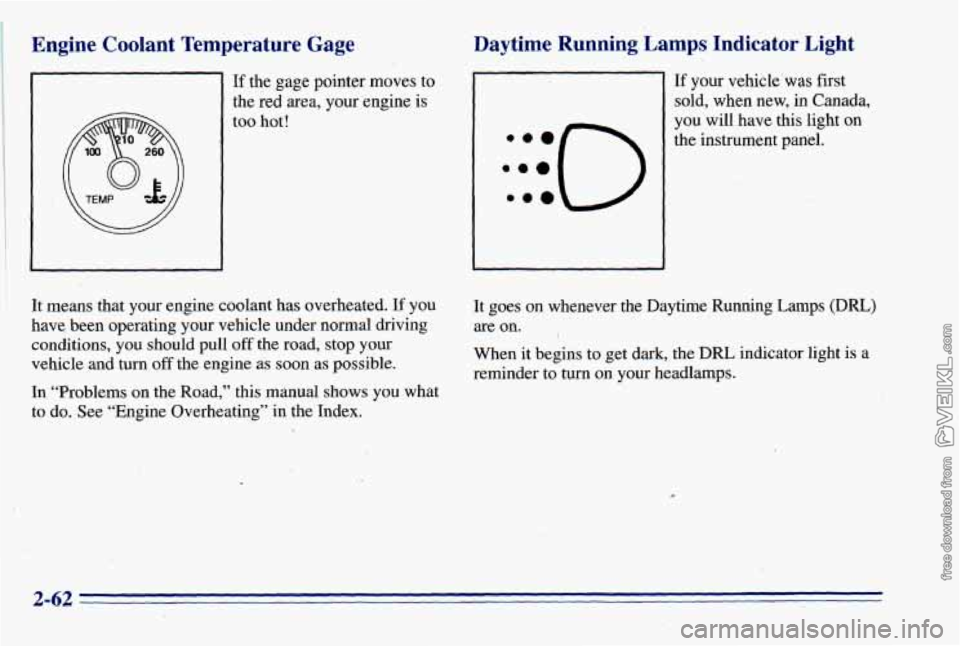
Engine Coolant Temperature Gage
If the gage pointer moves to
the red area, your engine is
too hot!
Daytime Running. Lamps, Indicator Light
:::O ..e
If your vehicle’was first
sold, when new, in Canada,
you will have this light on
the instrument panel.
It means that your engine coolant has overheated.
If you
have been operating your vehicle under normal driving
conditions, you should pull
off the road, stop your
vehicle and turn
off the engine as soon as possible. It goes
on whenever the Daytime Running Lamps (DRL)
are on. I
When it begins
to get dark, the DRL indicator light is a
reminder to
turn on your headlamps.
In “Problems on the Road,”
this manual shows you what
to do. See “Engine’Overheating” in the Index.
2-62
Page 189 of 372
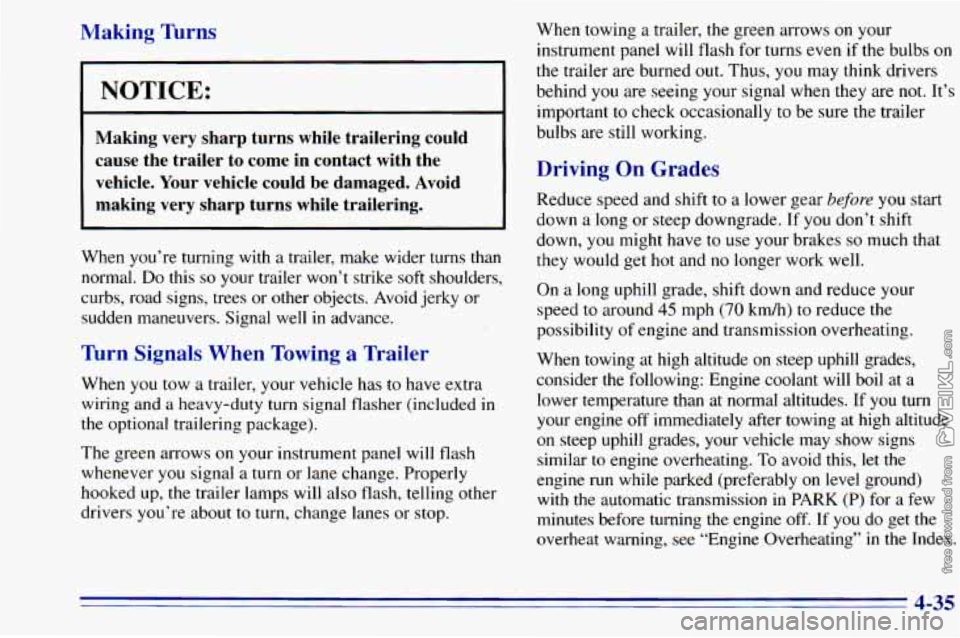
Making Turns
NOTICE:
Making very sharp turns while trailering could
cause the trailer to come in contact with the
vehicle. Your vehicle could
be damaged. Avoid
making very sharp turns while trailering.
When you’re turning with a trailer, make wider turns than
normal.
Do this so your trailer won’t strike soft shoulders,
curbs, road signs, trees or other objects. Avoid jerky or
sudden maneuvers. Signal well in advance.
Tbrn Signals When Towing a Trailer
When you tow a trailer, your vehicle has to have extra
wiring and a heavy-duty turn signal flasher (included
in
the optional trailering package).
The green arrows on your instrument panel will flash
whenever you signal a turn or lane change. Properly
hooked up, the trailer lamps will also flash, telling other
drivers you’re about to turn, change lanes or stop. When
towing
a trailer, the green arrows on your
instrument panel will flash for turns even if the bulbs
on
the trailer are burned out. Thus, you may think drivers
behind you are seeing your signal when they are not. It’s
important
to check occasionally to be sure the trailer
bulbs are still working.
Driving On Grades
Reduce speed and shift to a lower gear before you start
down a long or steep downgrade. If
you don’t shift
down, you might have to use your brakes
so much that
they would get hot and
no longer work well.
On a long uphill grade, shift down and reduce your
speed to around
45 mph (70 km/h) to reduce the
possibility
of engine and transmission overheating.
When towing at high altitude on steep uphill grades,
consider the following: Engine coolant will boil at a
lower temperature than at normal altitudes. If you turn
your engine off immediately after towing at high altitude
on steep uphill grades, your vehicle may show signs
similar to engine overheating.
To avoid this, let the
engine run while parked (preferably on level ground)
with the automatic transmission in
PARK (P) for a few
minutes before turning
the engine off. If you do get the
overheat warning, see “Engine Overheating” in
the Index.
4-35
Page 205 of 372
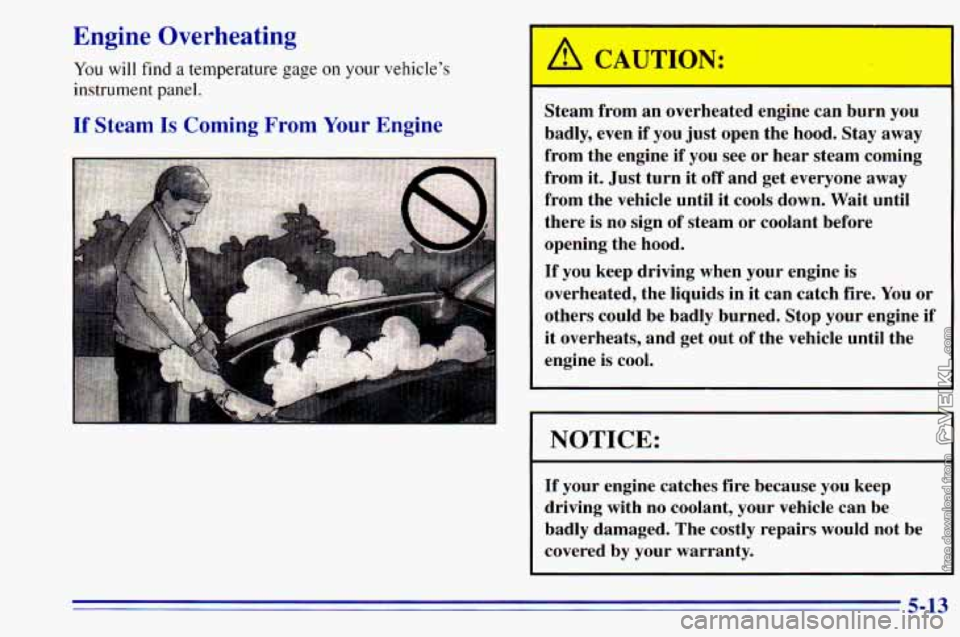
Engine Overheating
You will find a temperature gage on your vehicle’s
instrument panel.
If Steam Is Coming From Your Engine
Steam from an overheated engine can burn you
badly, even if you just open the hood.
Stay away
from the engine if you see or hear steam coming
from it. Just turn it off and get everyone away
from the vehicle until it cools down. Wait until
there is no sign of steam or coolant before
opening the hood.
If you keep driving when your engine is
overheated, the liquids in it can catch fire. You or
others could be badly burned. Stop your engine if
it overheats, and get out of the vehicle until the
engine is cool.
I NOTICE:
If your engine catches fire because you keep
driving with no coolant, your vehicle can be
badly damaged. The costly repairs would not be
covered by your warranty.
5-13
Page 255 of 372

What to Use Rear Axle
When to Check and Change Lubricant
Refer to the Maintenance Schedule to determine how
often to check the lubricant and when
to change it. See
“Scheduled Maintenance Services” in the Index.
How to Check Lubricant
If the level is below the bottom of the filler plug hole,
you’ll need to add some lubricant. Add enough lubricant
to raise the level to the bottom of the filler plug hole. Refer
to the Maintenance Schedule to determine what
kind of lubricant
to use. See “Recommended Fluids and
Lubricants” in the Index.
Engine Coolant
The cooling system in your vehicle is filled with new
DEX-COOL (orange-colored, silicate-free) engine
coolant. This coolant is designed to remain in your
vehicle for
5 years or 100,000 miles (166 000 km),
whichever occurs first.
The following explains your cooling system and how to
add coolant when it is low. If
you have a problem with
engine overheating, see “Engine Overheating’’ in
the Index.
A 50/50 mixture of water and the proper coolant for
your vehicle will:
0 Give freezing protection down to -34°F (-37°C).
Give boiling protection up to 265 “F (1 29°C).
0 Protect against rust and corrosion.
Help keep the proper engine temperature.
0 Let the warning lights and gages work as
they should.
6-25
Page 259 of 372
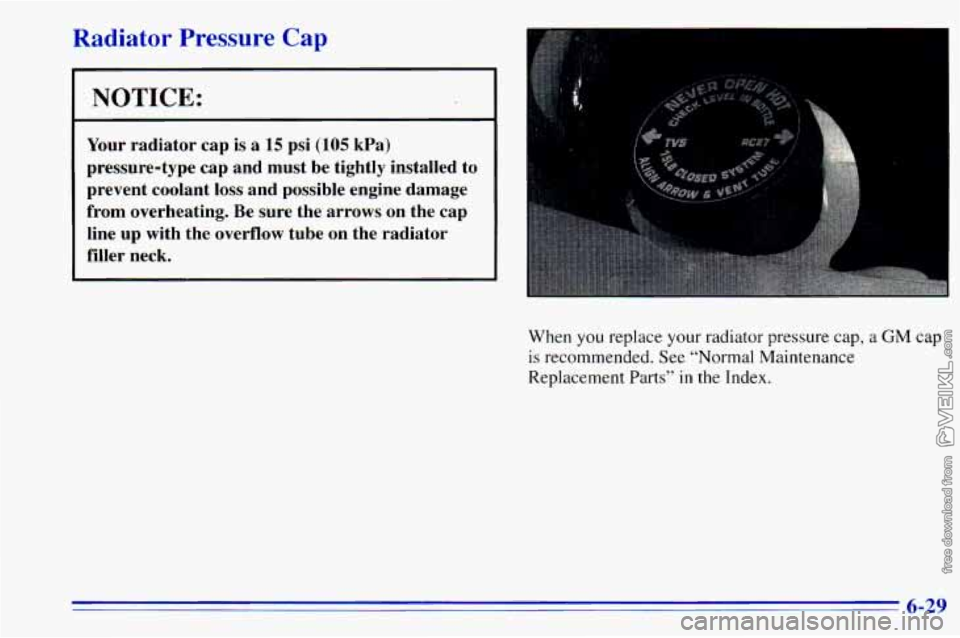
Radiator Pressure Cap
NOTICE:
Your radiator cap is a 15 psi (105 kPa)
pressure-type cap and must be tightly installed to
prevent coolant loss and possible engine damage
from overheating. Be sure the arrows on the cap
line
up with the overflow tube on the radiator
filler neck.
When you replace your radiator pressure cap, a GM cap
is recommended. See “Normal Maintenance
Replacement Parts” in the Index.
6-29
Page 272 of 372
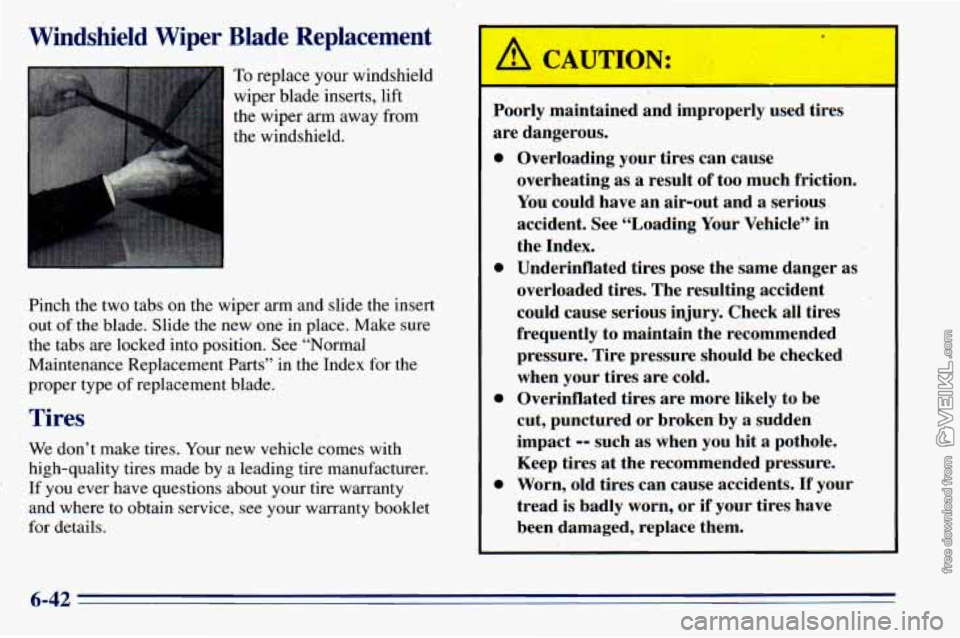
Windshield Wiper Blade Replacement
To replace your windshield
wiper blade ‘inserts, lift
the wiper arm away‘from
the windshield.
Pinch the two tabs on the wiper arm and slide
the ins1 ert
out of the blade. Slide the new one in place. Make sure
the tabs are locked into position. See “Normal
Maintenance Replacement
Parts” in the Index for the
proper type of replacement blade.
Tires
We don’t make tires. Your new vehicle comes with
high-quality tires made by a leading tire manufacturer.
‘ If you ever have questions about your tire warranty
and where to obtain service,
see your wai-ranty booklet
for details.
A CAUTION:
0
0
0
0
I
Poorly maintained and improperly used tires
are dangerous.
Overloading your tires can cause
overheating as a result of too much friction.’
You could have an air-out and a serious
accident. See “Loading Your Vehicle” in
the Index.
Underinflated tires pose the same danger as
overloaded tires. The resulting accident could cause serious injury. Check all tires
frequently to maintain the recommended
pressure. Tire pressure should be checked
when your tires are cold.
Overinflated tires are more likely to be
cut, punctured or broken by a sudden
impact
-- such as When you hit a pothole.
Keep tires
at the recommended pressure.
Worn, old tires can cause accidents.
If your
tread
is badly worn, or if your tires have
been damaged, replace them.
6-42
Page 363 of 372

Damage. Finish ........................ . . 6-56
Damage. Sheet Metal
............................ 6-56
Daytime Running Lamps
......................... 2-36
Daytime Running Lamps Indicator Light
............ 2-62
Dead Battery
................................... 5-2
Defects. Reporting Safety
......................... 8-8
Defensive Driving ............................... 4- 1
Defogger. Rear Window .......................... 3-7
Defrosting
..................................... 3-6
Dimensions. Vehicle
............................ 6-69
Dome Lamps
.................................. 2-37
Door Locks
....................................... 2-5
Sliding ...................................... 2-9
DrivePosition
................................. 2-20
DriverPosition
................................. 1-16
Driving City
........................................ 4-17
Defensive
.................................... 4-1
Drunken ..................................... 4-2
Freeway
.................................... 4-18
InaBlizzard ................................. 4-24
In Foreign Countries ........................... 6-4
In the Rain .................................. 4-14
Night
...................................... 4-13
OnCurves
................................... 4-8
On Grades While Towing
a Trailer ............... 4-35
On Hill and Mountain Roads
.................... 4-20
On Snow and Ice
............................. 4-22
Through Water
................... ....... 4-16
WetRoads
.................................. 4-14
Winter ...................................... 4-22
With a Trailer ................................ 4-33
Drunken Driving
................................ 4-2 Electrical
Equipment. Adding
........ 2- 16. 3.26. 6-60
Electrical System
............................... 6-60
Engine ........................................ 4-9
Coolant
..................................... 6-25
Coolant Heater
............................... 2-16
Coolant Level Check
.......................... 7-41
Cooling System Capacity
....................... 6-67
Cover
...................................... 6-15
Exhaust
..................................... 2-26
FuseBlocks
............................ 6-61. 6-64
Identification
................................ 6-59
OilLevelCheck
.............................. 7-41
Overheating
................................. 5-13
Running While Parked
......................... 2-26
Specifications
................................ 6-67
Starting
..................................... 2-15
Temperature Gage
............................ 2-62
Engineoil
.................................... 6-11
Adding
..................................... 6-12
Additives
................................... 6-14
Checking
................................... 6-12
Pressure Gage
........................... .... 2-60
Used
....................................... 6-15
Whentochange .............................. 6-14
Exhaust. Engine
................................ 2-26
Express-Down Window
........................ 2-28
Fabric Cleaning
............................... 6-50
Fiberglass Springs
.............................. 6-57
Filling Your Tank
................................ 6-5
Filter. Air
..................................... 6-69
Filter. Engine Oil
............................... 6-69
Finish Care
.................................... 6-54
9-3
Page 366 of 372

Maintenance When Trailer Towing ............... 4-36
Malfunction Indicator Lamp
...................... 2-58
ManualFrontSeat
............................... 1-1
Manual Lumbar Support .......................... 1-2
Methanol
...................................... 6-4
Mirrors
....................................... 2-38
Convex Outside
.............................. 2-39
Inside Day/Night Rearview
..................... 2-38
Outside
..................................... 2-39
Visor Vanity ................................. 2-49
MMT
......................................... 6-3
ModelReference
................................. vi
Mountain Roads ........ ................ 4-20
Net. Convenience
.............................. 2-46
Neutral
....................................... 2-19
New Vehicle Break-In
........................... 2- I3
Nightvision
................................... 4-13
Odometer
.................................... 2-53
Odometer. Trip
................................. 2-53
Off-Road Recovery
............................. 4- IO
Oil. Engine .................................... 6-11
Opener. Garage Door ............................ 2-43
Outside Mirror
................................. 2-39
Overhead Console
.............................. 2-42
Overheating Engine
............................. 5- I3
Owner Checks and Services
....................... 7-41
Owner Publications. Ordering ...................... 8-9
Paint Spotting. Chemical ........................ 6-57
Park
......................................... 2-18
Shifting Into
................................. 2-22
Shifting Out
of ............................... 2-25
AtNight
.................................... 2-13
Brake ...................................... 2-21
Brake Mechanism Check
....................... 7-44
Lots
....................................... 2-13
Over Things That Burn
......................... 2-25
With
a Trailer ................................ 4-36
Passing
....................................... 4-10
Payload
....................................... 4-28
Periodic Maintenance Inspections
.................. 7-45
Power Accessory Outlet
............................. 2-49
DoorLocks
................................... 2-5
Option Fuses
................................ 6-60
Seat ......................................... 1-3
Steering ..................................... 4-8
Steering Fluid
................................ 6-30
Windows
.................................... 2-27
Pregnancy, Use of Safety Belts
.................... 1-30
Problems on the Road
............................ 5-1
Publications, Service and Owner .................... 8-9
Parking
Radiator
..................................... 5-19
Radiator Pressure Cap ........................... 6-29
Radio Reception
................................ 3-26
Radios
........................................ 3-8
Rain. Driving In ................................ 4-14
Reading
Lamps ................................ 2-38
9-6